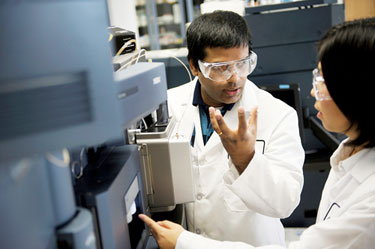
From the food industry to pharmaceutical and drug development, analytical testing requires robust tools for accurate measurements in complex matrices. Besides, the requirement to evaluate hundreds of samples at a rapid speed while ensuring data reliability and quality poses additional challenges. Liquid chromatography-mass spectrometry (LC-MS) is a robust tool that meets all these stringent requirements. Due to its efficiency and versatility, LC-MS testing labs are increasingly becoming desirable in several modern analytical applications.
LC-MS drug testing involves the physical separation of analytes, followed by their detection based on the mass-to-charge ratio. Due to its enhanced accuracy, selectivity, and sensitivity, LC-MS assays can detect analytes at microgram and nanogram levels. Besides, tandem methods such as LC-MS/MS services have further expanded their application in different domains of biomedical sciences. The current article discusses LC-MS laboratories and cutting-edge techniques for bioanalytical applications such as drug testing and biomarker services.
Cutting-edge LC-MS laboratories
Today, hybridized methods such as ligand binding assays combined with LC-MS testing are commonly developed in bioanalytical analysis. This combination provides complementary data, offers insights into the nature of the sample and target analytes, and allows more reliable and accurate drug efficacy and safety evaluations.
LC-MS are flexible enough to be complex with different modalities for rapid assay modifications. LC-MS/MS assays and HRMS approaches identify and quantify analytes, impurities, metabolites, and degradants, which can be difficult for standard ligand binding assays that suffer from cross-reactivity or matrix effects.
Today, LC-MS systems are increasingly being used in biotherapeutic drug development. LC-MS assays can help understand biotherapeutic structure and function, optimize assay performance and stability, monitor pharmacokinetic data, and assess impurities and degradation. Often, multi-domain biotherapeutics, such as masked and fusion proteins, are subjected to post-translational changes such as acetylation, glycosylation, or phosphorylation. These modifications can alter the pharmacokinetic and biological activity of biotherapeutics.
The multiplexing capacities of LC-MS assays help quantify the active concentrations as well as total concentrations of specific modifications that can help provide a comprehensive understanding of their impacts on the performance of biotherapeutic drugs. Besides, LC-MS assays help understand pharmacokinetic-related information such as half-life, degradation pathways, and drug clearance, which are all crucial for developing stable compounds and optimizing drug dosage.
Over the next decade, advances in LC-MS systems in terms of selectivity, sensitivity, and throughput will help detect and quantify analytes present at even low levels in complex matrices. These improvements will make way for LC-MS assay systems to be employed in a routine analysis. Advances in sample preparation techniques, along with improvement in throughput and reproducibility via automation and miniaturization, are the next evolution of the LC-MS system. Besides, the use and growth of HRMS technology will keep increasing and may prove beneficial while quantifying large and complex drug molecules such as intact proteins. However, this advanced technology will require adequate standardization and optimization of methods for quantifying proteins in biological samples. Additionally, the use of artificial intelligence and big data will be more common and help in efficient data analysis, processing, and evaluations.
In Conclusion
LC-MS laboratories have unique techniques and cutting-edge technologies to advance and accelerate biomedical and drug development studies.


